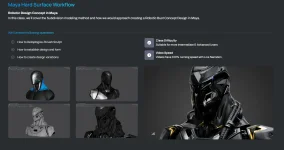yesundercover
Senior Member
CG-Moderator
Premium Member
Trusted Seller
Trusted Uploader
Malware Free Provider

ZBrush and Maya Hard Surface Workflow
“Master professional-grade hard surface modeling with ZBrush and Maya. Discover hybrid workflows used by industry artists to sculpt, retopologize, and render precision-based assets for film, games, and product visualization.”
Introduction to ZBrush and Maya Hard Surface Workflow
In the world of high-end CGI, combining ZBrush’s sculpting power with Maya’s precision modeling is the ultimate solution for creating advanced hard surface designs. Whether you're working on sci-fi armor, robotics, vehicles, or props, this hybrid pipeline provides the flexibility of sculpting with the accuracy of polygonal modeling.
This workflow is ideal for VFX professionals, game developers, concept artists, and product designers seeking refined control over form, edge flow, and surface detail while meeting strict production standards.
➺ Why Use a ZBrush + Maya Workflow?
✔ Seamlessly combines organic sculpting with mechanical modeling.
✔ Ideal for hard surface detailing, boolean operations, and precision refinement.
✔ Offers robust UV, rigging, and animation prep in Maya after sculpting.
✔ Bridges artistic creativity with technical discipline.
✔ Streamlines concept to final asset in a non-destructive pipeline.
➺ What Will You Learn in This Workflow?
✔ How to block out forms in ZBrush using Dynamesh and ZModeler.
✔ Efficient use of creasing, Live Booleans, and panel loops.
✔ Transferring meshes between ZBrush and Maya using GoZ or FBX.
✔ Retopology workflows in Maya for clean edge flow and animation-readiness.
✔ UV mapping, texturing, and baking normals/displacement maps.
✔ Rendering polished hard surface assets with Arnold or Redshift.
Workflow Series Breakdown: ZBrush to Maya Pipeline
➺ 1. Initial Blocking in ZBrush
✔ Use Dynamesh to sketch the primary shape and silhouette.
✔ Leverage IMM brushes for bolts, panels, and inserts.
✔ Apply panel loops and crease settings for hard edges.
➺ 2. Detailing and Boolean Techniques
✔ Use Live Booleans for subtractive design (vents, gaps, mechanical inserts).
✔ Refine bevels, chamfers, and transitions using the ZModeler brush.
✔ Keep detailing in layers for maximum flexibility.
➺ 3. Retopology in Maya
✔ Export high-poly mesh from ZBrush to Maya.
✔ Use Maya’s Quad Draw tool to manually retopologize surfaces.
✔ Maintain clean edge loops, quad-based geometry, and animation-friendly flow.
➺ 4. UV Unwrapping and Baking
✔ Create UVs using Maya’s UV Toolkit or RizomUV (if preferred).
✔ Bake normal, curvature, and AO maps using Marmoset or Substance.
✔ Export maps for PBR texturing or real-time integration.
➺ 5. Shader and Render Setup
✔ Use Arnold or Redshift for material assignment and final lighting.
✔ Apply normal and displacement maps for added detail without geometry bloat.
✔ Render turntables and hero shots with AOVs and depth passes.
➺ 6. Export for Games or Film Pipelines
✔ Optimize topology and texture resolution.
✔ Export in FBX format for Unreal Engine or Unity.
✔ Integrate with rigging and animation systems for pipeline-ready delivery.
Best Practices for ZBrush and Maya Integration
➺ Maintain a Clean Naming Convention
✔ Helps in asset tracking, exporting, and importing between software.
✔ Essential for large productions or team collaboration.
➺ Use GoZ for Speed, FBX for Stability
✔ GoZ is fast for iterative workflows, but FBX is preferred for clean handoffs.
➺ Check Scale Consistency
✔ Ensure both software use consistent scale units to avoid export/import issues.
➺ Keep Edge Flow Simple
✔ Prioritize clean topology over sculpted detail for animation and deformation.
➺ Visualize Normals and Smoothing Groups
✔ Check normals in Maya before baking to avoid artifacts.
✔ Use soft/hard edges correctly to preserve intended forms.
Who Should Use This Workflow?
✔ VFX professionals working in asset creation for film or TV.
✔ Game developers building high-fidelity props and environments.
✔ Concept artists transforming ideas into production-ready models.
✔ Technical artists optimizing sculpts for real-time use.
Recommended Software & Tools
✔ Core: ZBrush, Maya
✔ Retopo: Maya Quad Draw, TopoGun
✔ UVs: Maya UV Toolkit, RizomUV
✔ Texturing: Substance Painter, Quixel
✔ Rendering: Arnold, Redshift
✔ Realtime: Unreal Engine, Unity
Support the Creator: Follow expert hard surface artists on Patreon
**Legal Disclaimer: CGPeers.in is an independent educational platform providing informational content shared by its global user community. We DO NOT host, store, promote, or distribute any copyrighted material, illegal downloads, or pirated content. Responsibility for all uploaded content lies solely with the individual user who submitted it.
By accessing this website, you agree that you are doing so at your own risk. CGPeers.in, its owners, administrators, hosting providers, and domain registrars assume no liability for any legal claims, damages, or actions arising from third-party user submissions or external links.
CGPeers.in operates under strict compliance with international copyright laws, including the Digital Millennium Copyright Act (DMCA). For any copyright concerns, please file an official complaint via our DMCA Policy. We respect original creators and encourage all users to support legal, official products and avoid unauthorized use of intellectual property. CGPeers.in is committed to compliance with Google AdSense policies by maintaining a high-quality, policy-friendly environment focused on education, creativity, and industry knowledge. For any legal inquiries or takedown requests, please contact us through the official communication channels available on our website. Support Creativity. Respect Copyright. Protect Innovation.
Last edited:



